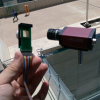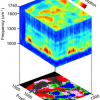
Journal Spotlight: The discrimination power of a hyperspectral imaging system for image segmentation or object detection is determined by the illumination, the camera spatial–spectral resolution, and both the pre-processing and analysis methods used for image processing. In this study, we methodically reviewed the alternatives for each of those factors for a case study from the food industry to provide guidance in the construction and configuration of hyperspectral imaging systems in the visible near infrared range for food quality inspection. We investigated both halogen- and LED-based illuminations and considered cameras with different spatial–spectral resolution trade-offs. At the level of the data analysis, we evaluated the impact of binning, median filtering and bilateral filtering as pre- or post-processing and compared pixel-based classifiers with convolutional neural networks for a challenging application in the food industry, namely ingredient identification in a flour–seed mix. Starting from a basic configuration and by modifying the combination of system aspects we were able to increase the mean accuracy by at least 25 %. In addition, different trade-offs in performance-complexity were identified for different combinations of system parameters, allowing adaptation to diverse application requirements.
Free to read
C. Blanch-Pérez del Notario, C. López-Molina, A. Lambrechts and W. Saeys, “Hyperspectral system trade-offs for illumination, hardware and analysis methods: a case study of seed mix ingredient discrimination”, J. Spectral Imaging 9, a16 (2020). https://doi.org/10.1255/jsi.2020.a16




